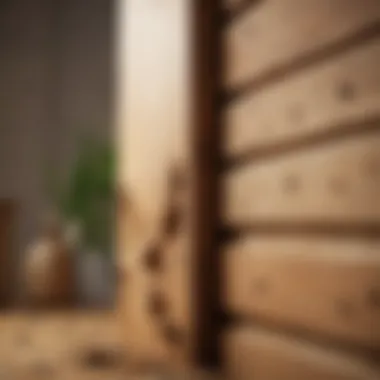Rapid Strategies for Effective Termite Removal


Intro
Identifying the signs of termite activity helps to address the problem before it escalates. Homeowners must be vigilant and aware of what to look for. After identification comes the critical decision on how to eliminate these pests. By choosing the right approach—whether tackling it alone or hiring a professional—homeowners can reclaim their space efficiently. Moreover, understanding preventive measures ensures that termites do not return after treatment.
This article discusses various strategies that can lead to successful termite eradication. With a clear understanding of these options, readers can act decisively against any potential termite threats.
Understanding Termites
Termites are among the most destructive pests that can infest a home. To effectively combat this issue, it is essential for homeowners to understand termites’ biology, habits, and signs of their presence. This knowledge serves as the foundation for choosing effective elimination strategies. Understanding these aspects equips homeowners with the tools needed to identify infestations early and take appropriate actions. It can also minimize the potential for severe damage and costly repairs.
Biology of Termites
Types of Termites
The most common types of termites are subterranean, drywood, and dampwood. Subterranean termites, for instance, are prevalent in many areas and are known for their extensive tunnels below the soil. They can cause significant damage since they often infest structures unnoticed. Drywood termites, on the other hand, live within the wood itself, making them harder to detect until visible signs of damage occur. Recognizing these types is crucial because it influences the approach for effective termite elimination. Choosing the right type of treatment directly impacts the success of your efforts against these pests.
Life Cycle and Habits
Termites have a fascinating life cycle that typically includes stages such as eggs, nymphs, and adults. Understanding their lifecycle is important for treatment efficacy. For instance, some stages are more vulnerable to various treatments. Adult termites, which can reproduce quickly, form the basis of any colony. Rapid reproduction can lead to a swift increase in population, creating a dire situation for homeowners. Recognizing their habits, such as their preference for damp wood or proximity to soil, can aid in prevention and eradication efforts.
Signs of Infestation
Identifying Damaged Wood
One of the most telling signs of a termite infestation is the presence of damaged wood. Termites consume wood from the inside out, leaving a thin exterior layer intact. Homeowners should regularly inspect wooden structures, looking for signs of hollowed-out wood or unusual patterns. Identifying this damage early can significantly reduce repair costs and allow for swift action. Knowing how to recognize such damage contributes to the overall strategy for pest control and prevention.
Visible Frass and Mud Tubes
Frass, or termite droppings, and mud tubes are clear indicators of a termite problem. Frass typically appears as small, pellet-like materials, while mud tubes are soil-like structures that termites build to protect themselves while traversing between nesting and feeding areas. Observing these signs can help confirm the presence of termites and facilitate timely action. Quick identification of these features can lead to more effective treatment solutions before infestations escalate.
Swarmers and Their Implications
Swarmers are winged adult termites that emerge during certain seasons in search of new nesting sites. The presence of swarmers should be treated as a significant warning sign of a possible infestation. The sight of these insects often indicates the maturity of a termite colony, which means that extensive damage can already be occurring. Paying attention to swarming season and recognizing these pests in flight can inform proactive measures before it’s too late.
"Timely identification of termite signs can save homeowners thousands in repairs."
Initial Assessment of the Infestation
Assessing the extent of a termite infestation is crucial for effective eradication. Without understanding how widespread the problem is, homeowners may underestimate the situation, leading to inadequate treatment and possibly severe damage over time. The initial assessment encompasses a thorough examination of both the visible symptoms and the underlying structural integrity of the property. This section highlights two significant elements: conducting a home inspection and evaluating damage severity. Each element focuses on gathering relevant data to inform subsequent actions.
Conducting a Home Inspection
Areas to Inspect
When conducting a home inspection for termites, specific areas require careful scrutiny. Focusing on basements, crawl spaces, and foundations is essential, as termites often thrive in these locations. Additionally, inspecting attics may reveal signs of infestation that are not visible from the ground.
This emphasis on physical areas stems from the nature of termites, who typically inhabit damp, dark environments. Wood-to-soil contact points are also critical since they often serve as entry pathways for termites moving toward structural timber.
Key characteristics of inspecting these areas include the accessibility and prevalence of signs such as mud tubes and damage to wooden structures. This method is a beneficial choice as it allows homeowners to take immediate action upon discovery. However, one limitation is the potential difficulty in accessing certain areas, which may require specialized tools or professional assistance.
Using Technology for Detection
Modern home inspections can benefit significantly from technology. Devices such as moisture meters, infrared cameras, and acoustic emission devices can help detect termite activity that is not visible to the naked eye. These technologies provide valuable insights into areas where termites may be nesting or feeding, effectively expanding the inspection's reach beyond just physical observation.
The key characteristic of using technology for detection lies in its ability to uncover hidden infestations early. This proactive approach can save homeowners significant time and resources in the long run. However, the downside is that such technology can be costly, and there may be a learning curve for effective use.


Evaluating Damage Severity
Assessing Structural Integrity
Assessing the structural integrity of a home in relation to a termite infestation is vital. This step involves examining how much damage has occurred and determining if the home remains safe for occupancy. Significant structural damage may compromise the safety of the property or lead to costly repairs.
A crucial aspect of this evaluation is the technique of tapping or probing wooden structures. Homeowners can identify hollowed-out areas caused by termites. The ability to spot such issues effectively highlights the importance of this stage in the overall assessment, making it a critical step in deciding on an appropriate treatment plan. However, thorough evaluations often require expertise, which may necessitate hiring a professional inspector.
Estimating Financial Impact
Estimating the financial impact of a termite infestation helps homeowners understand the potential costs associated with both treatment and repairs. This process entails assessing the extent of the damage, which can influence repair costs and insurance claims.
The key characteristic of estimating financial impact lies in its immediacy. Once homeowners know the potential costs, they can make informed decisions concerning treatment options. Furthermore, this understanding allows for planning and budgeting effectively. However, the process can be complicated, especially if the damage is extensive, as hidden issues may exacerbate initial estimates.
Quick Elimination Techniques
Quick elimination of termites is essential for homeowners facing an infestation. These pests can cause significant damage in a short time. Therefore, swift action is required to limit structural harm and economic costs. This section covers various effective techniques that can be employed to eradicate termites efficiently.
Home Remedies
Using Boric Acid
Boric acid is a widely known pesticide that is effective in termite control. This substance works by disrupting the digestive system of termites, eventually leading to their death. A key characteristic of using boric acid is its low toxicity to humans and pets, making it a preferable option for homeowners concerned about chemical exposure. This makes it a popular choice in home remedy solutions for termite elimination. Additionally, boric acid can be easily applied in powder form or mixed with water for baiting.
However, its application requires some caution. Since boric acid is most effective on contact, it is crucial to apply it directly to the infested areas. One downside is that it may take time to observe significant results, as it works gradually. Still, its effectiveness and safety profile have secured its place in this article for quick elimination techniques.
Applying Essential Oils
Essential oils, like orange oil, have gained attention for their pest-repellent properties. The specific aspect of applying essential oils is their natural origin and appealing scent. For instance, d-limonene, found in orange oil, can effectively kill termites on contact. This characteristic makes essential oils a beneficial alternative for those looking for less harmful options.
However, while essential oils may repel termites, they often do not have the long-lasting effects of chemical treatments. The unique feature of essential oils lies in their accessibility and ease of use, as they can be used in sprays or diffusers. One limitation to note is that their efficacy can vary based on concentration and medium used for application. Nevertheless, they remain a valuable choice for quick action against termites.
DIY Bait Stations
DIY bait stations offer homeowners a cost-effective way to manage termite infestations. These systems contain bait that attracts termites, allowing them to ingest a slow-acting pesticide. The defining characteristic of DIY bait stations is their simplicity in construction and deployment.
With basic materials, homeowners can create these stations and place them strategically around their yard. The unique advantage of this method is that it enables homeowners to monitor the infestation closely over time. However, establishing effectiveness often requires patience, as it may take weeks before significant results appear. Therefore, while DIY bait stations are an efficient option for rapid action, they still necessitate ongoing observation and potentially supplemental treatment.
Chemical Solutions
Liquid Termiticides
Liquid termiticides represent a vital chemical solution in the realm of termite control. These substances create a barrier in the soil, effectively preventing termites from entering a structure. A key characteristic is their immediate effect, which offers reassurance to homeowners facing severe infestations. Liquid termiticides often penetrate the soil, providing lasting protection.
However, one must consider application requirements. Using liquid termiticides usually means engaging professional pest control services due to the necessity of precise application and safety protocols. The unique feature of this method is the immediate treatment approach, which ensures rapid results. Yet, reliance on professionals might deter some homeowners due to cost considerations.
Foam and Gel Treatments
Foam and gel treatments are innovative methods gaining traction in termite control. These formulations penetrate wood and wall voids, delivering treatment directly to the affected areas. A significant advantage of foam and gel is the precision of application, reducing excess chemical use and potential exposure.
Homeowners appreciate this targeted approach, which also minimizes the impact of chemical residues. The unique feature here lies in their ease of use; they can be employed in hard-to-reach areas. However, these treatments often require professional expertise for successful application, which may pose challenges for DIY enthusiasts.
Fumigation Oversight
Fumigation oversight is a comprehensive solution designed for severe infestations. This process involves sealing the entire structure and introducing gas to eradicate termites. A primary characteristic of this method is its effectiveness in tackling widespread infestations, making it a reliable choice. When done correctly, fumigation can reach every crevice and corner of the house, ensuring thorough coverage.
However, it demands careful planning and adherence to safety protocols. Homeowners must vacate their homes during treatment, leading to temporary displacement. The unique feature of fumigation is its capacity for 100% eradication of termites. Despite the potential inconveniences, it serves as a powerful option for rapid elmination when other methods are insufficient.


The choice of elimination strategy depends on the severity of infestation, budget, and comfort level with chemical exposure. By understanding the options available, homeowners can make informed decisions to protect their properties.
Professional Treatment Options
Professional treatment options play a critical role in the effective eradication of termite infestations. While DIY methods can be effective for minor cases, larger or more established infestations often demand the expertise of seasoned pest control professionals. These experts bring advanced equipment, extensive knowledge, and a deep understanding of termite behavior. This can lead to quicker and more sustainable results, minimizing further damage to structures.
When to Call in Experts
Assessing the Infestation Size
Assessing the infestation size is a key component in determining the appropriate course of action. It focuses on how widespread the termite damage is within a property. This assessment involves a thorough inspection of potential infest control areas such as beams, walls, and underground spaces.
By evaluating the size of the infestation, pest control professionals can decide whether localized treatments will suffice or if a more comprehensive approach is needed. The key characteristic of this assessment lies in its accuracy. It allows for tailored solutions that address the unique challenges posed by each individual situation. This makes it a vital consideration in our article.
The unique feature of evaluating infestation size is that it often involves the use of advanced tools like infrared cameras and moisture meters. These tools offer a more precise diagnosis and can uncover hidden problem areas. The advantage of this approach is that it leads to more effective treatment decisions. However, the potential downside is that invasive inspection techniques may sometimes be required, which could disrupt the living space temporarily.
Understanding Treatment Costs
Understanding treatment costs is essential to the decision-making process regarding termite elimination. Knowing the financial implications helps homeowners prepare for the investment necessary to combat termite issues. Different methods of treatment, whether chemical or physical, vary in expense based on factors such as the severity of the infestation, the type of treatments selected, and the size of the Area affected.
A key characteristic of understanding treatment costs is the ability to justify the expense against potential structural damage and repairs caused by termites, which can be significantly higher. This makes it a beneficial aspect of choosing professional treatment options in this article.
The unique feature of analyzing treatment costs lies in the difference between short-term savings and long-term benefits from effective treatment. Investing in a thorough treatment now can save money in prevention and repairs later on. However, the disadvantage here is that some advanced treatments can seem expensive upfront, potentially discouraging homeowners from seeking the help they need.
Comparing Pest Control Services
Evaluating Qualifications
Evaluating qualifications of pest control services is crucial for ensuring that the chosen professional is capable of effectively addressing termite problems. This includes checking credentials, certifications, and reviews from previous clients. Such preparation contributes to the overall aim of achieving effective termite removal with peace of mind.
The primary characteristic of evaluating qualifications is rooted in understanding the expertise and experiences of the pest control technician. Their ability to identify issues and apply proper treatment methods is critical to success, making this evaluation a popular step in our article's recommendations.
One unique feature here is that properly qualified professionals will often carry licenses that reflect their adherence to state and federal regulations. This ensures that they meet industry standards. The advantage is the increased likelihood of a thorough and safe treatment but the downside may involve extensive research and vetting process, which can be time-consuming.
Analyzing Treatment Plans
Analyzing treatment plans is necessary for homeowners looking to select the best course of action against termites. It's about understanding what each type of treatment entails, how it will be implemented, and what expected results can be anticipated. This careful consideration aligns well with the goal of successful termite elimination.
A key feature of analyzing treatment plans is that different companies may offer various methods, ranging from chemical applications to bait systems. Each treatment has different implications for effectiveness, timing, and safety. This makes it beneficial for homeowners to be well informed on their choices.
Unique to this comparison is the capacity to adapt plans based on specific building structures or individual family needs. For example, some treatments are tailored to sensitive environments, making them safer for children and pets. However, analyzing treatment plans might result in confusion due to the complexity and variety of options available.
Post-Treatment Monitoring
Regular Inspections
Regular inspections after treatment is critical for ensuring no further termite activity occurs. These inspections help to identify early signs of a recurrence and provide homeowners reassurance that their living spaces are secure. Its contribution to the overall objective of managing termites effectively is invaluable.
The core characteristic of regular inspections is the ongoing commitment it requires from homeowners. This might involve scheduling periodic visits with pest control professionals to maintain vigilance against termites, which is advantageous for long-term property health.
A unique aspect to note is that some pest control companies offer monitoring services that include traps or stations. This approach provides real-time awareness of any termite presence. The advantage of this is a proactive stance toward prevention; on the other hand, regular inspections may impose a continuous cost on homeowners, which can be a disadvantage.
Signs of Recurrence
Recognizing signs of recurrence is crucial for a homeowner’s long-term strategy against termites. This element serves as an early warning system. Knowing what to look for allows an immediate response to any new infestations.


Key characteristics of undertaking this vigilance include assessing wood for signs of damage or observing for mud tubes. This focus on detail helps in safeguarding the property from further damage and aligns with the article's intent.
One unique feature in observing signs of recurrence involves understanding that damage can happen quickly after treatment. Efficient identification might save costly repairs later. Still, a disadvantage is that not all signs are easily noticeable, which can lead to a delayed response that allows infestations to escalate.
Preventative Measures
Taking preventative measures against termite infestations is critical for any homeowner. Implementing strategies to safeguard your home can save significant costs and emotional distress down the line. Prevention measures are proactive steps taken to impede the entry and establishment of termites. They also help maintain a healthy living environment. Being aware of these strategies is essential for every homeowner who wishes to protect their property.
Home Maintenance Practices
Proper Ventilation
Proper ventilation is a key factor in protecting your home from termites. It helps to regulate humidity levels, reducing moisture accumulation in potentially vulnerable areas. Termites thrive in damp conditions, so ensuring effective airflow is essential. The key characteristic of proper ventilation is that it allows warm, moist air to escape, replacing it with cooler, drier air. This is a beneficial choice for maintaining overall home integrity.
One unique feature of proper ventilation is its role in preventing mold and mildew growth, which can attract pests. Its advantages include minimizing termite risk and fostering a healthier air quality indoors. However, neglecting ventilation can lead to trapped moisture and create an inviting environment for pest infestations.
Moisture Control Techniques
Moisture control techniques serve another critical role in termite prevention. By keeping your home's moisture levels in check, you reduce the appeal of your property to termites. A key characteristic of moisture control is using systems such as dehumidifiers and proper drainage that directs water away from the foundation.
Moisture control techniques are a popular choice among homeowners because they not only help in preventing termites but also enhance overall health due to reduced humidity. A unique feature of these techniques is the installation of vapor barriers in crawl spaces. The main advantage is to create an unfavorable environment for termites, but improper installation can lead to unintended consequences, such as creating condensation problems.
Landscaping Tips
Choosing Resistant Plants
Choosing resistant plants is an effective strategy in maintaining termite-free landscaping. Certain plants, like marigolds or rosemary, naturally deter termite activity. This strategy not only enhances your garden's aesthetic but adds an additional layer of defense against infestations. The key characteristic of resistant plants is that they contain elements that are naturally repugnant to termites.
A unique feature of this approach is its dual benefit. Not only do these plants help in repelling termites, but they also bring vibrancy to your garden. Their advantages lie in their low maintenance needs and their roles as an eco-friendly solution. The only downside could be a limited selection depending on your local climate and soil conditions.
Effective Mulch Placement
Effective mulch placement is another important aspect of landscaping to prevent termites. Organic mulch can entice termites, while mineral-based options, like gravel or stone, do not. The key characteristic here is to place mulch at least 15 inches away from foundations. This simple practice effectively blocks termites from easily accessing wood structures.
A unique feature of proper mulch usage is its aesthetic appeal while simultaneously protecting against pests. The advantages include conserving moisture in soil while improving plant growth. However, the disadvantage is that improper placement or types can attract termites more than they deter them, so careful consideration should be taken.
"Preventing termite infestations is far more effective than attempting to eliminate them once they establish themselves in your home."
The End
The conclusion serves as a critical component of the article, encapsulating the essential lessons learned about effective termite elimination strategies. It emphasizes the urgency of addressing termite infestations promptly to protect homes from the extensive damage these pests can inflict. Homeowners must be aware of both the signs of an infestation and the various solutions available. This knowledge not only safeguards property but also conserves financial resources by preventing extensive damage repairs.
In this article, we have extensively outlined strategies that range from identifying infestations through careful inspection to understanding the benefits of DIY treatments versus hiring professional services. This comprehensive overview enables homeowners to make informed decisions based on their unique circumstances.
Ultimately, the key elements to remember from this article include using proper inspection techniques, exploring effective remediation methods, and implementing robust preventative measures after treatment.
Notably, with termites being such a prevalent issue, the understanding of diverse approaches ensures homeowners are well-equipped for any situation. Whether through applying chemical solutions or leveraging home remedies, the proper strategy can lead to rapid elimination and long-term protection.
"Knowledge and prompt action are the best defense against termite infestations."
Summary of Effective Strategies
Several effective strategies have been discussed throughout the article. These strategies can be summarized as follows:
- Identifying Infestation Early: Regular home inspections are crucial in catching termites early. Look for signs like damaged wood, frass, and mud tubes.
- Applying Home Remedies: Options such as boric acid and essential oils can be useful initial responses to minor infestations, providing a solution without harsh chemicals.
- Utilizing Chemical Solutions: For larger infestations, using liquid termiticides or foam treatments may be necessary to ensure thorough eradication.
- Professional Help When Needed: If the infestation is severe, enlisting the expertise of pest control professionals is often the most effective course of action.
- Implementing Preventative Measures: After addressing an infestation, continuous maintenance is essential. This includes proper ventilation, moisture control, and landscaping tips like choosing resistant plants to reduce risk.
These strategies highlight a balanced approach to termite management, ensuring homeowners have practical solutions at hand.
Final Recommendations
In sum, effective termite elimination hinges on a proactive and informed approach. Here are some final recommendations for homeowners:
- Conduct Routine Inspections: Regularly check for signs of termite activity, especially in areas prone to moisture.
- Educate Yourself and Others: Stay informed about recent developments in pest control, as this knowledge can empower you and your community.
- Choose the Right Treatment: Weigh the pros and cons of DIY methods versus professional treatments based on the severity of the infestation.
- Implement Prevention Protocols: Take preventive measures seriously to create a long-term barrier to potential infestations. Proper home maintenance can make a significant difference.
- Stay Connected with Experts: Engage with pest control specialists for help and advice to create a robust defense against termites.
By following these recommendations, homeowners can effectively manage and prevent termite invasions, ensuring the safety and longevity of their homes.















